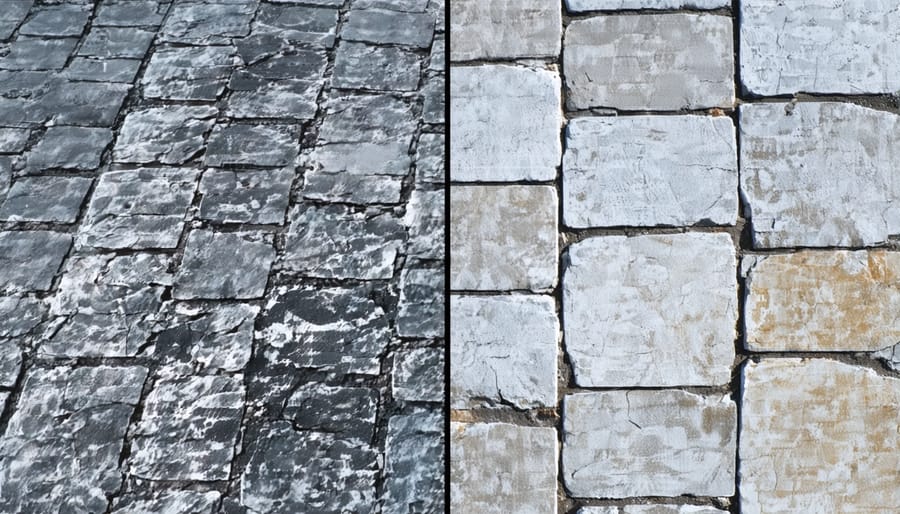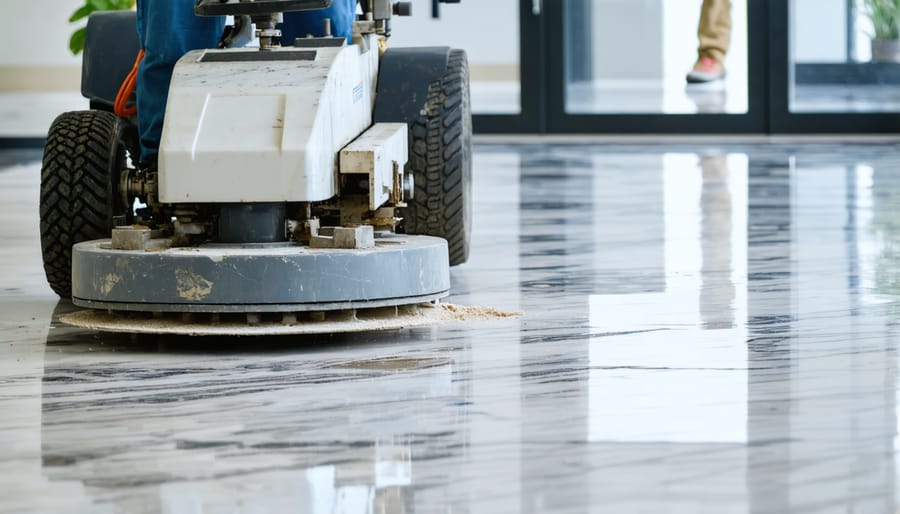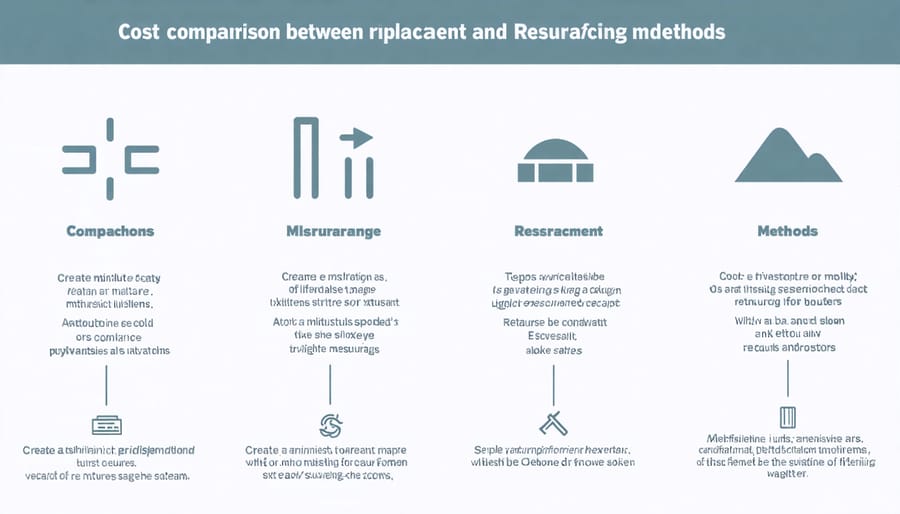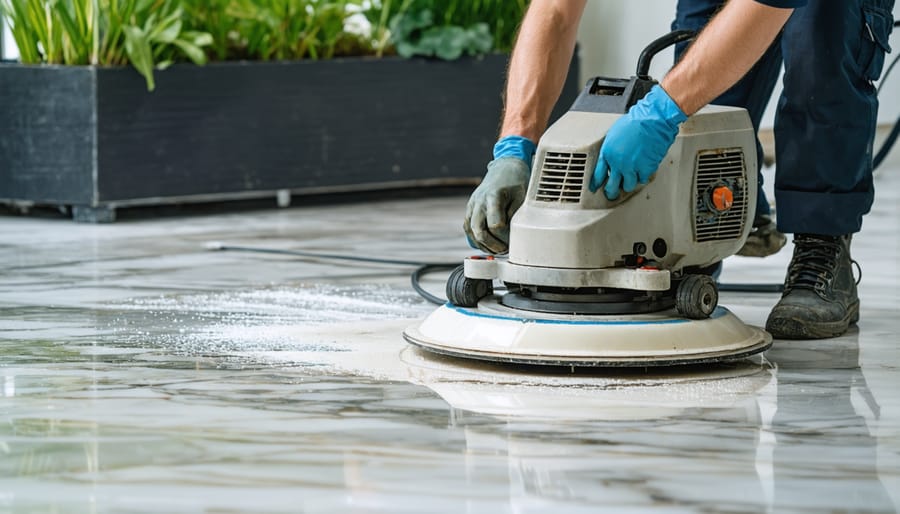Stone resurfacing has revolutionized the art of preserving stone surfaces, offering transformative solutions for worn, damaged, or aging natural stone installations. Modern resurfacing techniques combine cutting-edge technology with time-tested craftsmanship to restore the inherent beauty of marble, granite, limestone, and other stone materials without the need for complete replacement.
Advanced diamond grinding systems and eco-friendly chemical treatments now enable professionals to achieve museum-quality finishes at a fraction of traditional restoration costs. This sustainable approach not only extends the life of existing stone installations but also maintains the authentic character and historical value of architectural elements while reducing environmental impact.
For property owners and design professionals, stone resurfacing represents a critical intersection of aesthetic enhancement, practical maintenance, and investment protection. Whether addressing commercial facades, heritage buildings, or residential installations, today’s resurfacing methods deliver exceptional results that meet both performance requirements and design expectations.
The evolution of stone resurfacing technology has created opportunities for precise restoration work that preserves the original material’s integrity while incorporating modern durability standards. This balance of preservation and enhancement makes stone resurfacing an invaluable solution in contemporary architecture and historic preservation.
Understanding Stone Surface Deterioration
Common Signs of Wear
Natural stone surfaces typically exhibit several distinct signs of wear that indicate the need for resurfacing. Etching, characterized by dull spots or light marks on polished surfaces, commonly occurs when acidic substances come into contact with the stone. Deep scratches and scuff marks, particularly visible in high-traffic areas, can diminish the stone’s aesthetic appeal and protective surface layer.
Discoloration patterns and staining that persist despite regular cleaning often signal penetrative damage to the stone’s surface. In outdoor applications, weathering effects may manifest as spalling (flaking of the surface) or pitting, especially in areas exposed to freeze-thaw cycles or harsh environmental conditions.
Light reflecting unevenly across the surface indicates an inconsistent finish, while lippage (height variation between adjacent tiles) becomes more pronounced as edges wear down. Water absorption tests can reveal compromised sealing – if water no longer beads on the surface but instead creates dark spots, the stone’s protective barrier has deteriorated.
Physical indicators like crumbling grout lines, loose tiles, or hollow sounds when tapped suggest underlying structural issues that may require attention beyond surface treatment.

Impact of Environmental Factors
Environmental factors play a crucial role in the deterioration of stone surfaces, necessitating regular maintenance and occasional resurfacing. Weather conditions, particularly freeze-thaw cycles and excessive moisture, can cause stone to crack, chip, or develop surface irregularities. UV exposure may lead to fading or discoloration, especially in darker stones.
Daily usage patterns significantly impact stone surfaces. High-traffic areas experience accelerated wear, resulting in dull spots, scratches, and uneven textures. The type of foot traffic matters too – areas exposed to abrasive materials like sand or rock salt typically show faster deterioration.
Chemical exposure represents another significant concern. Acidic substances, including common household cleaners and food spills, can etch calcium-based stones like marble and limestone. Even seemingly harmless substances like wine or citrus juice can leave permanent marks if not cleaned promptly. Salt exposure, particularly in coastal areas or regions where de-icing products are used, can penetrate stone surfaces and cause spalling or scaling.
Understanding these environmental impacts helps property owners develop appropriate maintenance schedules and choose suitable resurfacing methods to protect their stone investments.
Cutting-Edge Resurfacing Technologies
Diamond Grinding Systems
Diamond grinding systems represent the cutting edge of stone resurfacing technology, combining precision engineering with advanced abrasive materials. These systems utilize industrial-grade diamond particles bonded to metal or resin pads, which systematically remove layers of stone to achieve the desired finish. Modern machines feature variable speed controls and automated leveling systems, ensuring consistent results across large surfaces.
The latest developments include planetary grinding heads that rotate in multiple directions simultaneously, allowing for more efficient material removal and superior flatness. Computer-controlled systems now monitor grinding pressure and speed in real-time, preventing surface damage and optimizing the restoration process.
These systems come in various sizes, from handheld units for small repairs to large ride-on machines for commercial projects. The diamond tooling is available in different grits, progressing from coarse to fine, enabling professionals to achieve finishes ranging from honed to high-gloss polish. Environmental considerations have also driven innovation, with newer systems incorporating advanced dust collection mechanisms and water recycling features that minimize waste and protect air quality during operation.

Nano-crystallization Processes
Nano-crystallization represents a cutting-edge advancement in stone resurfacing technology, utilizing specialized chemical treatments that penetrate deep into the stone’s surface. This innovative process creates microscopic crystalline structures that bond with the stone’s natural minerals, effectively sealing and protecting the material while enhancing its appearance.
During treatment, nano-particles fill microscopic pores and imperfections, creating a durable protective barrier that resists staining, moisture, and everyday wear. The process not only restores the stone’s original luster but also improves its structural integrity and longevity. Unlike traditional sealers that form a surface coating, nano-crystallization becomes an integral part of the stone’s structure.
Key benefits include enhanced resistance to acid etching, superior water repellency, and improved scratch resistance. The treatment also helps maintain the stone’s natural breathability while providing long-lasting protection that can extend the material’s lifespan by several years.
This eco-friendly solution requires minimal maintenance and reduces the need for harsh cleaning chemicals. Property owners typically notice immediate improvements in their stone’s appearance, with treated surfaces displaying deeper colors and enhanced clarity. The treatment is particularly effective for marble, limestone, and travertine surfaces in both residential and commercial applications.
Laser Surface Treatment
Laser surface treatment represents a cutting-edge approach to stone restoration, offering unprecedented precision and minimal material loss. This innovative technology uses concentrated light beams to selectively remove surface contaminants, discoloration, and weathering effects while preserving the stone’s underlying structure.
The process involves directing controlled laser pulses at the stone surface, which cause micro-ablation of unwanted materials without damaging the substrate. This selective removal makes it particularly valuable for historically significant structures and delicate architectural elements where traditional mechanical methods might prove too aggressive.
One of the key advantages of laser treatment is its ability to clean without physical contact, eliminating the risk of mechanical stress on the stone. The technology can effectively remove biological growth, rust stains, graffiti, and atmospheric soiling while maintaining the stone’s natural patina and surface texture.
However, laser treatment requires specialized equipment and expertise, making it more expensive than conventional methods. The process is typically reserved for high-value restoration projects or situations where traditional techniques might cause damage. Despite the higher cost, the precision and non-invasive nature of laser treatment often justify the investment, particularly for preserving culturally significant stonework.
Sustainable Resurfacing Practices
Green Restoration Methods
In recent years, the stone restoration industry has embraced sustainable design practices that minimize environmental impact while maintaining exceptional results. Water-based sealants and low-VOC compounds have replaced traditional solvent-based products, significantly reducing harmful emissions during the restoration process. These eco-friendly alternatives not only protect the environment but also create safer working conditions for restoration professionals.
Mechanical restoration methods, such as diamond-grit polishing pads with water recycling systems, have become industry standards. These systems capture and filter water during the polishing process, reducing waste and conserving resources. Additionally, biodegradable cleaning agents derived from natural enzymes and plant-based materials offer effective cleaning solutions without introducing harmful chemicals into the ecosystem.
Many restoration professionals now utilize dustless grinding systems that capture particulate matter at the source, improving air quality and reducing cleanup requirements. These systems protect both workers and building occupants while preventing stone dust from entering the environment.
The integration of locally sourced materials for patching and repairs further reduces the carbon footprint of restoration projects. When combined with energy-efficient equipment and proper waste management protocols, these green restoration methods deliver outstanding results while preserving our natural resources for future generations.
Water Conservation Techniques
Modern stone resurfacing techniques have evolved to address growing environmental concerns, particularly regarding water usage. Professional contractors now employ eco-friendly restoration methods that significantly reduce water consumption while maintaining superior results.
Closed-loop water recycling systems represent a major advancement in sustainable stone resurfacing. These systems capture, filter, and reuse water throughout the resurfacing process, reducing consumption by up to 90% compared to traditional methods. The filtered water can be used multiple times before disposal, making the process both cost-effective and environmentally responsible.
Low-flow equipment and precision spray systems further optimize water usage by delivering exactly the right amount of water needed for each application. These systems often incorporate pressure-controlled nozzles that minimize overspray and waste while ensuring optimal surface preparation and finishing.
Dry polishing techniques have also gained popularity, particularly for smaller projects or specific stone types. These methods use specialized diamond abrasives that require minimal or no water during the resurfacing process. While not suitable for all applications, dry polishing can dramatically reduce water consumption when appropriate.
Many contractors now offer water audit services before beginning large resurfacing projects, helping clients understand and optimize their water usage while maintaining the highest quality results. This approach not only conserves water but often leads to significant cost savings on utility bills.
Cost-Benefit Analysis
Investment vs. Replacement
When considering stone restoration options, the financial implications of resurfacing versus complete replacement deserve careful analysis. Resurfacing typically costs 30-40% of what full replacement would require, making it an attractive option for budget-conscious property owners. For example, resurfacing a 500-square-foot marble floor might cost $2,500-3,500, while complete replacement could exceed $8,000-10,000.
Beyond immediate costs, resurfacing offers additional financial benefits. The process usually takes less time, reducing business downtime or living space disruption. It also eliminates expenses associated with demolition, disposal, and new material transportation. Moreover, resurfacing preserves existing structural elements, preventing potential complications that might arise during complete removal.
However, replacement might be more cost-effective in certain scenarios. Severely damaged stones with deep structural issues or those requiring frequent resurfacing may warrant replacement. The decision should consider factors like the stone’s age, condition, historical value, and intended use.
Long-term maintenance costs also factor into the equation. Properly resurfaced stone can last 10-15 years with regular maintenance, while new stone installation might last 20-30 years. Property owners should weigh these lifecycle costs against their budget and timeline requirements to make an informed decision.

Long-term Value Considerations
When evaluating stone resurfacing options, understanding their long-term implications is crucial for making informed decisions about long-term stone preservation and maintenance. Different resurfacing methods offer varying degrees of durability and require distinct maintenance approaches.
Mechanical polishing typically provides the most durable finish, lasting 15-20 years with proper maintenance. This method requires periodic resealing every 3-5 years but demands minimal day-to-day upkeep. The dense, smooth surface resists staining and wear, making it ideal for high-traffic areas.
Chemical resurfacing, while less invasive, generally needs renewal every 5-7 years. However, it offers excellent protection against acid etching and requires only annual maintenance treatments. The chemical barrier created helps prevent deep staining and surface degradation.
Honing presents a middle-ground solution, offering 8-12 years of durability with bi-annual maintenance. This method creates a more natural, matte finish that disguises minor wear and scratches, making it particularly suitable for residential applications.
Crystallization delivers impressive initial results but typically needs refreshing every 3-4 years. While maintenance requirements are moderate, the process helps strengthen the stone’s surface structure, potentially extending its overall lifespan.
Regular cleaning with pH-neutral products and prompt attention to spills remains essential regardless of the chosen method, ensuring optimal performance and longevity of the resurfaced stone.
Stone resurfacing represents a valuable investment in preserving and enhancing natural stone surfaces, offering property owners and designers a sustainable alternative to complete replacement. Throughout this guide, we’ve explored the various methods, technologies, and considerations essential for successful stone restoration projects.
Remember that proper assessment of your stone’s condition is crucial before beginning any resurfacing work. Whether dealing with marble, granite, limestone, or other natural stone materials, choosing the right technique and working with qualified professionals can significantly impact the final results.
For optimal outcomes, maintain a regular maintenance schedule after resurfacing, including proper cleaning and sealing as recommended by industry experts. This proactive approach will extend the life of your restored surface and protect your investment.
Consider sustainability factors when planning your project, including water usage, chemical selection, and waste management. Modern resurfacing techniques offer eco-friendly options that align with contemporary environmental standards while delivering excellent results.
If you’re ready to begin your stone resurfacing project, start by consulting with certified stone restoration professionals who can assess your specific needs and recommend appropriate solutions. Remember to request samples, references, and detailed quotes before proceeding with any work.
By following these guidelines and working with qualified experts, you can successfully restore your stone surfaces to their original beauty while ensuring longevity and performance for years to come.










